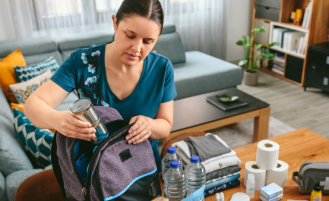5 Steps to Tidying Up Your Medicine Cabinet
April 09, 2024
Is spring cleaning on your mind? As a pharmacist for more than 20 years, I have seen the baskets full of medications that people sometimes keep around their homes. Often, these baskets contain a messy, potentially-dangerous potpourri of drugs that are many years old. When it comes to medications, tidying up is about more than your sanity, it is about your safety.

According to Safe Kids Worldwide, medication is the leading cause of poisoning in kids—leading to the death of a child every 12 days. Even adults can accidentally take medication incorrectly due to poor vision or if there are too many drugs to take and track.
Here is my 5-step method for tidying up your medicine cabinet:
1. Gather all of your medications in one spot.
Many of us store our medications in various places around the house. Perhaps we have supplements on the kitchen counter or in a drawer to keep handy as we take with meals. Also, we may keep prescription drugs in the bathroom, too, or antacids, maybe a sleep aid on the nightstand we take before bedtime. Keep your medications all in one place, maybe in one medicine cabinet, so you can easily see what you have in your drug inventory.
2. Throw out all expired medications.
Many of us deliberately stock up on over-the-counter medications, items like TheraFlu and Nyquil or fever reducers like Tylenol, which is acetaminophen, because once we start feeling sick, we want to take them right away and not have to run to the drug store.
The bottom line is, if they are expired, throw them out. Be joyful that you did not have to use them, but recognize that they are dangerous to keep around. As medications age, some lose their efficacy. For instance, if you are giving Tylenol to a child who has a high fever and is suffering a febrile seizure, if the Tylenol is expired, it is less effective. Sometimes, if people take medications that do not seem to be working, they will take more than the recommended dosage, which can lead to accidental overdose.
Make sure not to keep prescription medications and over-the-counter products that have expired. If you have painkillers left over from an injury or surgery that you want to keep because you think it may come in handy someday, be safe and just throw them out.
3. Locate ideal storage sites for your medications.
Medicine cabinets and bathrooms seem to go together. But, a room that has heat, humidity and steam coming from the shower is not actually a good place to store medicines. Unless the manufacturer recommends differently, medicines need to be stored in a dry and cool place, so they can work properly in your body.
Choose a cabinet in your home that is up high and out of children’s reach and sight. If you choose to store medicines in the kitchen, make sure they are out of reach of children, even if they were to climb up on a countertop or chair.
Other tips on storage, particularly if you are taking multiple prescriptions: consider placing a medication tracker on the inside of the cabinet door for easy reference. Also, I highly recommend a pill organizer which allows you to place your pills for the whole week in the correct days, cutting down the risk of accidental overdoses or taking medicine incorrectly.
4. Organize your medications by category.
I recommend separating your prescription medications from over-the-counter medicines. And, while it may sound obvious, I suggest separating eye drops from other drops, such as for the ear. In my practice, I have seen patients make the mistake of putting the wrong type of drop in the wrong place. Also, keeping children’s medications separate from adults’ medications will help avoid getting the wrong dose or even the wrong medicines.
Organizing by category is also beneficial as you may see that you have several ibuprofen bottles, for instance. Do not combine them into one as they likely have different expiration dates. By organizing them correctly, you can make a point of using up first the ones that are set to expire sooner.
5. Make your medicines hard to access.
The most important thing is to prevent your medicines from getting into the wrong hands. Depending on your children’s ages, you may think about using child-resistant caps on medicine bottles (though remember that child-resistant does not mean childproof).
Lock up your medication cabinet. According to the U.S. Drug Enforcement Agency (DEA), 6.5 million Americans misused controlled prescription drugs, a majority of which were taken from family and friends. Consider keeping the Poison Control Centers' hotline number handy, either in your phone or on a sticker in your cabinet: 800.222.1222.
Many pharmacies accept unused medicines, or Public Health or a police station may accept them, too.
By putting your mind to it, and downsizing your drug inventory, your home will be more than just tidier, it will be safer.
On the DEA site, enter your zip code and you will get a location near you for disposing your medicines safely.









